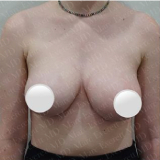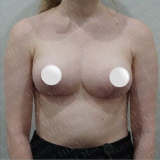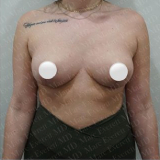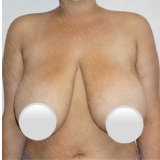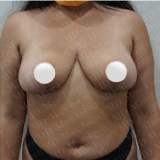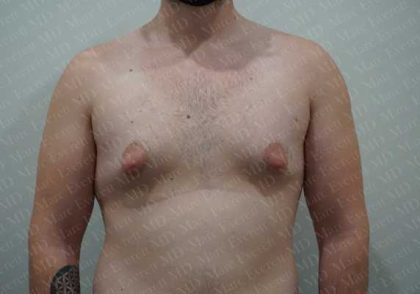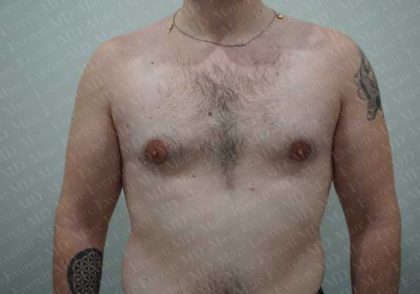Gynecomastia
Consultations offered at our two convenient locations in Manhattan, NY and Queens, NY

Gynecomastia is a condition characterized by enlarged male breasts due to excess fat and glandular tissue. The condition affects men of all ages and can have a significant impact on their self-confidence and body image. Through the removal of excess tissue, a surgeon can sculpt the patient’s chest to create a more masculine contour.
If enlarged male breast tissue has affected the way you wear your clothing, your self-confidence by the pool, and made you feel uncomfortable in your own body, then consider receiving gynecomastia treatment at The Everett Clinic. At locations in Manhattan and Queens, Dr. Marc Everett offers this procedure to male patients interested in increasing their self-esteem and improving their masculine appearance.
To learn more about this life-changing procedure, call (212) 774-7715 or contact us online.
Contents
- 1 Before and After Photos
- 2 About Gynecomastia
- 3 Gynecomastia Techniques
- 4 Male Breast Reduction
- 5 Benefits of Gynecomastia
- 6 Who is a Candidate for Gynecomastia?
- 7 Personal Consultation
- 8 Preparation
- 9 Gynecomastia Procedure
- 10 Recovery
- 11 Results
- 12 How Much Does Gynecomastia Treatment Cost in Manhattan?
- 13 FAQ
- 14 References
Before and After Photos
About Gynecomastia
Gynecomastia typically affects younger and older men, at times in the male lifespan when the hormones testosterone and estrogen are typically unbalanced. (1) Beginning in adolescence, breast hypertrophy can continue through to early adulthood, with the incidence of the condition increasing again after the age of 65. (2) When testosterone levels are low, or estrogen levels high, excess fat and tissue can accumulate in the breasts. However, hormonal imbalance and gynecomastia can develop as the result of several factors outside of the usual periods of imbalance, and may result during:
- Post-puberty development
- The use of certain medications
- Aging
- Weight gain
Whatever the underlying reason, this condition can cause lowered self-confidence and serious psychological distress, as the appearance of the chest is an important part of many men’s self-image. It can also lead to physical discomfort, including tenderness, nipple sensitivity and chafing. Luckily, expert surgeons like Dr. Everett can perform gynecomastia surgery and address these symptoms directly. This treatment has been clinically proven to improve the social, sexual, and psychological lives of the patients who receive it. (3)
Gynecomastia Techniques
Dr. Everett utilizes several different gynecomastia surgery techniques including the liposuction method, and the direct tissue excision method, depending on each patient’s unique condition. In more severe cases, patients may need a male breast reduction.
Liposuction
If the patient’s excess breast tissue is mostly fat cells and contains little to no skin sagging, Dr. Everett prefers liposuction. The procedure involves making inconspicuous incisions in the chest and armpit areas to allow the insertion of a cannula, a thin metal tube that breaks up and suctions out fatty tissue. The incisions are small and may be located on the border of the areola, along the natural crease of the lower chest, on the side of the chest, or up in the armpit. Dr. Everett makes multiple incisions to be able to sculpt the chest from different angles.
Renuvion/J-Plasma
For patients who have a small degree of excess skin or wish for a tighter, more sculpted chest appearance, Dr. Everett can also utilize the skin-tightening effects of Renuvion for patients with gynecomastia. This is a device used in conjunction with a liposuction procedure that applies focused radiofrequency energy and helium gas directly to the loose skin and tissue from the underside of the skin. This energy stimulates the production of collagen, a structural protein that promotes healthy cell repair and growth. When new collagen takes hold in the skin, it can have a rejuvenating and tightening effect, which can significantly improve the aesthetic results of gynecomastia surgery by liposuction alone.
Tissue Excision
The tissue excision method is best for patients with mostly excess glandular tissue, and may sometimes need to be paired with the above procedures. Dr. Everett makes a small incision on the lower border of the areola to provide access to the underlying tissues. After he loosens the excess glandular tissue, he excises it directly through the periareolar incision. Patients with moderate to severe amounts of excess tissue and skin sagging are good candidates for this technique. If fatty tissue is present in addition to glandular tissue, then the liposuction and excision methods may be combined to provide comprehensive treatment. If excess skin is also an issue and needs to be removed, then Dr. Everett may make additional incisions to create a tighter and more masculine contour.
Male Breast Reduction
Patients with more severe presentations of gynecomastia or those who have had massive weight loss may have a degree of extra skin, fat, and glandular tissue to require a male breast reduction surgery. This operation may sound similar to the female breast reduction but it is stylized and performed with entirely different aesthetic goals in mind. The female breast reduction aims to utilize the remaining breast tissue to create as full, round, and projecting of a breast mound as possible while the male breast reduction is a more minimalist approach, using one of several designs to create as squared and flat of an appearance as possible.
Benefits of Gynecomastia
There are several notable benefits to receiving gynecomastia surgery from Dr. Everett. These include:
- Improving your appearance by achieving a more masculine and muscular chest
- Directly addressing the discomforting symptoms of gynecomastia such as chafing and nipple sensitivity
- Increasing your self-confidence and boosting your self-esteem
- Regaining control over your body and your appearance
Who is a Candidate for Gynecomastia?
Adult men of any age can undergo gynecomastia surgery to reduce enlarged breasts and sculpt the appearance of the chest. Generally speaking, the earlier in a patient’s life that they receive this surgery, the better. Gynecomastia can have cumulative adverse psychological effects on your self-esteem, so we recommend coming in as soon as you are able to undergo surgery. To be eligible, you should be in relatively good health, to ensure the safety of this treatment. You should also have realistic expectations about what this procedure can do for you. A healthy diet and regular exercise remain the best way to stay healthy and maintain your results.
Personal Consultation
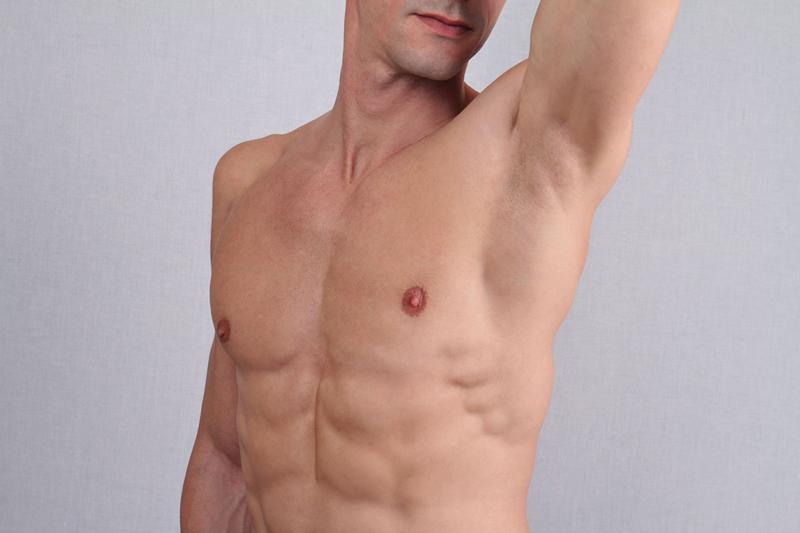
At your consultation, Dr. Everett will thoroughly explain the details of this treatment so you understand exactly what it entails. We can answer your questions and address your concerns. You can tell us all about your aesthetic goals, and we will let you know how we can bring you closer to achieving them. Be sure to tell us about any past surgeries, conditions, and prescriptions. We will also perform a physical exam to assess your condition. With this information, we can determine if surgery is a safe option, as well as how we can make your treatment smoother and more successful. We will develop a personalized treatment plan for you, and with this, we will provide an accurate cost estimate for your treatment. At the end of your consultation, we will schedule your procedure appointment and let you know what to expect moving forward.
To schedule your consultation at the Everett Clinic in Manhattan or Queens, call (212) 774-7715 or fill out this form.
Preparation
Preparing for your gynecomastia surgery is a crucial step in the treatment process. It involves the steps that you can take to make your procedure safer and improve your results by increasing your ability to heal. Based on what we find at your consultation, we may ask you to change your prescription intake. Other preparation steps include:
- Leading a healthy and active lifestyle
- Avoiding blood-thinning substances like ibuprofen, aspirin, vitamin E, and certain herbal supplements
- Quitting nicotine for the duration of your treatment to avoid unnecessary complications
- Preparing your home for recovery by fostering a comfortable and stress-free environment
- Arranging for a ride home from our facilities on the day of your surgery
Gynecomastia Procedure
When you come in for your gynecomastia surgery, you will be greeted discreetly at Dr. Everett’s private surgery center on 5th Ave. Your operation may be under either general or local anesthesia, as determined at your consultation. After you are made comfortable under anesthesia by our board-certified anesthesiologist, Dr. Everett will begin the surgery by making the incisions necessary for your treatment plan. He will then perform liposuction, tissue excision, or a combination of both to reduce the excess tissue in the chest. In the process, he will meticulously sculpt natural-looking contours that result in a more masculine and firmer appearance. Where indicated, Dr. Everett will perform Renuvion skin tightening. After the procedure, we will monitor you as the anesthesia wears off in our comforting recovery room. You will be free to go home with your escort when you are determined to be stable for discharge by our board-certified anesthesiologist and dedicated recovery nurse.
Recovery
After undergoing gynecomastia surgery, you should expect to spend two to three weeks of downtime recovering. Most patients can return to work within one week, depending on which technique Dr. Everett uses. You can resume exercise and strenuous activity typically two to three weeks after surgery, or when you have completely healed.
We will wrap your chest in a compression garment immediately following the procedure to provide support to the chest as it heals and helps minimize swelling. In addition to the swelling, typical side effects include tenderness, bruising, and loss of sensation in the treatment area. These symptoms are usually temporary and will gradually subside over several months. We recommend our nutritional support program to expedite the coalescence of swelling and bruising and support rapid healing.
Results
You will notice a reduction in the size of your chest immediately, though your final results will take two to three months to develop fully as the swelling continues to diminish and the extra skin retracts. The results of gynecomastia surgery can last a lifetime, although weight gain, using certain medications, and medical conditions can result in the return of excess tissue. Eating well and exercising daily can help to prevent the recurrence of your gynecomastia symptoms.
How Much Does Gynecomastia Treatment Cost in Manhattan?
The cost of your gynecomastia surgery will depend on the techniques that Dr. Everett employs, along with other factors related to your personalized treatment plan. To learn more about gynecomastia treatment in New York, call (212) 774-7715 or visit our contact page.
FAQ
Can gynecomastia go away naturally?
Gynecomastia is largely related to hormonal imbalance, and a variety of causes can make this condition better or worse. If you have been unable to reduce the size of your breasts by addressing possible causes, and your symptoms have remained stable for several years, gynecomastia surgery may be the best course of action.
Will insurance cover my gynecomastia surgery?
Although gynecomastia is a medical condition, insurance companies will always unfairly consider the treatment to be cosmetic in nature. Despite our near-universal success with having female breast reduction covered by insurance, we are unable to do so for gynecomastia.
Is gynecomastia surgery painful?
While gynecomastia surgery is invasive, surgeons administer anesthesia or sedation to their patients to completely prevent discomfort during surgery. Patients may feel some discomfort during recovery, but this resolves in a matter of days.
Will there be scars after gynecomastia surgery?
There will be some small scars after gynecomastia surgery. However, their visibility will depend on factors such as incision placement, genetics, and individual healing abilities. Over time, scars tend to fade and become less noticeable.
References
- Swerdloff RS, Chiu Ming Ng. Gynecomastia: Etiology, Diagnosis, and Treatment. Nih.gov. Published July 7, 2019. https://www.ncbi.nlm.nih.gov/books/NBK279105/
- Vandeven HA, Pensler JM. Gynecomastia. PubMed. Published 2020. https://www.ncbi.nlm.nih.gov/books/NBK430812/
- Holzmer SW, Lewis PG, Landau MJ, Hill ME. Surgical Management of Gynecomastia. Plastic and Reconstructive Surgery – Global Open. 2020;8(10):e3161. doi:https://doi.org/10.1097/gox.0000000000003161


